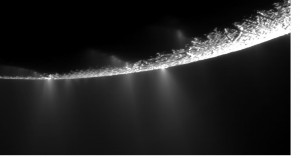FRIDAY, 1 JULY 2011
 The Cassini-Huygens mission was launched in 1997 as a joint venture between NASA and the European and Italian space agencies to study Saturn and its many natural satellites [1]. While the Huygens probe was released to land on Titan, Cassini orbited the planet and made flybys of its moons. In 2005 it discovered icy plumes shooting from the surface of Enceladus and has more recently been able to fly directly through them. During these passes, a cosmic dust analyser measured the composition of the icy particles, and found that they have an ocean-like composition. This suggests that they come from underground reservoirs rather than from the icy surface [2].
The Cassini-Huygens mission was launched in 1997 as a joint venture between NASA and the European and Italian space agencies to study Saturn and its many natural satellites [1]. While the Huygens probe was released to land on Titan, Cassini orbited the planet and made flybys of its moons. In 2005 it discovered icy plumes shooting from the surface of Enceladus and has more recently been able to fly directly through them. During these passes, a cosmic dust analyser measured the composition of the icy particles, and found that they have an ocean-like composition. This suggests that they come from underground reservoirs rather than from the icy surface [2].Tidal activity and radioactive decay are keeping these underground oceans warm. Together with the presence of organic chemicals, this liquid water has made Enceladus the most hospitable spot in the Solar System, outside Earth, for life as we know it. Future missions that can test for biomarkers, such as a high ratio of carbon-12 to carbon-13 isotopes, or preferential occurrence of ‘L’ or ‘D’ isomers of amino acids, will be needed to determine whether or not life exists at this distant outpost [3].
Written by Robert Jones
References:
- http://saturn.jpl.nasa.gov/mission/introduction/
- A salt-water reservoir as the source of a compositionally stratified plume on Enceladus. Postberg, F., Schmidt, J., Hilier, J., Kempf, S & Srama, R. Nature 474, 620-622 doi:10.1038/nature10175
- http://www.nature.com/news/2011/110531/full/news.2011.337.html
